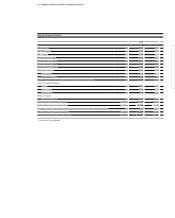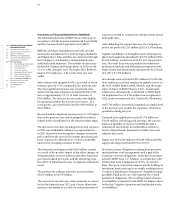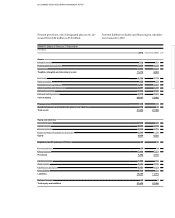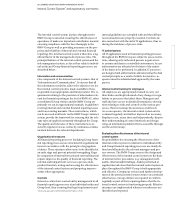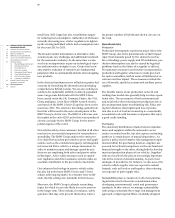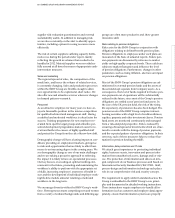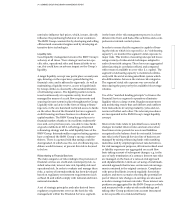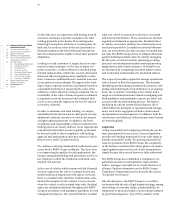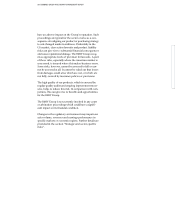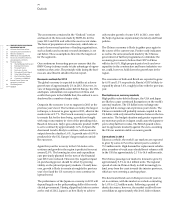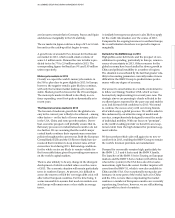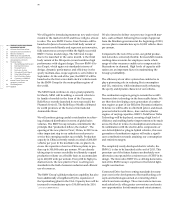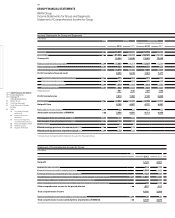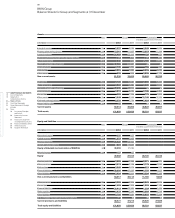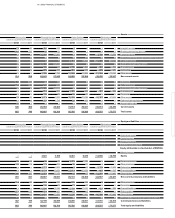BMW 2012 Annual Report Download - page 71
Download and view the complete annual report
Please find page 71 of the 2012 BMW annual report below. You can navigate through the pages in the report by either clicking on the pages listed below, or by using the keyword search tool below to find specific information within the annual report.
71 COMBINED GROUP AND COMPANY MANAGEMENT REPORT
rates) also influence fuel prices, which, in turn, directly
influence the purchasing behaviour of our customers.
The BMW Group counters this by developing and selling
efficient and economical engines and by developing al-
ternative drive technologies.
Liquidity risks
Good liquidity management ensures the BMW Group’s
solvency at all times. Were strategic and sector-spe-
cific risks, operational risks and financial risks to oc-
cur,
this could have an adverse impact on the Group’s
liquidity.
A target liquidity concept was put in place several years
ago, drawing on the experience gained during the
financial crisis, and is adhered to rigorously. As well as
maintaining a liquidity reserve, access to liquid funds
by Group entities is ensured by a broad diversification
of refinancing sources. The liquidity position is
moni-
tored continuously at a separate entity level and
managed by means of a cash flow requirements and
sourcing forecast system in place throughout the Group.
Liquidity risks can arise in the form of rising refinanc-
ing costs on the one hand and restricted access to funds
on the other. Most of the Financial Services segment’s
credit financing and lease business is refinanced on
capital markets. The BMW Group has good access to
financial markets thanks to its excellent creditworthi-
ness and, as in previous years, was able to raise funds
at good conditions in 2012, reflecting a diversified
refinancing strategy and the solid liquidity base of the
BMW Group. Internationally recognised rating agencies
have confirmed the BMW Group’s strong
creditwor-
thiness.
There is a general risk that ratings could be
downgraded,
in which case the cost of refinancing
con-
ditions would increase; at present this risk is deemed
to
be low.
Risks relating to Financial Services
The main categories of risk relating to the provision of
financial services are credit and counterparty risk,
re-
sidual value risk, interest rate risk, liquidity risk and
operational risk. In order to evaluate and manage these
risks, a variety of internal methods has been developed
based on regulatory environment requirements (such
as Basel II) and which comply with national and inter-
national
standards.
A set of strategic principles and rules derived from
regulatory requirements serves as the basis for risk
management within the Financial Services segment.
At
the heart of the risk management process is a clear
division into front- and back-office activities and a com-
prehensive internal control system.
In order to ensure that the segment is capable of bear-
ing the risks to which it is exposed (i.e. its “risk-bearing
capacity”), we monitor the segment’s total exposure to
major risks. This involves measuring unexpected losses
using a variety of value-at-risk techniques adapted to
each relevant risk category. These losses are aggregated
(after factoring in correlation effects) and compared
with resources available to cover risks (i.e. equity). The
segment’s risk-bearing capacity is monitored continu-
ously with the aid of an integrated limit system which
also differentiates between the various risk categories.
The segment’s total risk exposure was covered at all
times during the past year by the available risk-coverage
volumes.
Use of the “matched funding principle” to finance the
Financial Services segment’s operations eliminates
liquidity risks to a large extent. Regular measurement
and monitoring ensure that cash inflows and outflows
from transactions in varying maturity cycles and cur-
rencies will offset each other. The relevant procedures
are incorporated in the BMW Group’s target liquidity
concept.
Interest rate risks relate to potential losses caused by
changes in market interest rates and can arise when
fixed interest rate periods for assets and liabilities
recognised in the balance sheet do not match. Interest-
rate risks in the Financial Services line of business are
managed by raising refinancing funds with matching
maturities and by employing interest rate derivatives.
For risk management purposes, all interest-related asset
or liability exposures are aggregated on a cash flow
basis taking account of subsequent changes, e. g. in the
case of early termination of a contract.
Interest rate
risks
are managed on the basis of a value-at-risk approach
and stipulated limits. Limits are set using a benchmark-
oriented approach that focuses on
interest rate
arrange-
ments contained in the original contracts. Compliance
with prescribed limits is tested regularly. Sensitivity
analyses and stress scenarios showing the potential im-
pact of
interest rate
changes on earnings are also used
as tools to manage
interest rate
risks. These
interest rate
positions are aggregated for the BMW Group as a whole
and measured with a value-at-risk methodology and
taking other Group positions into account (structured
as far as possible on a risk-neutral basis).


